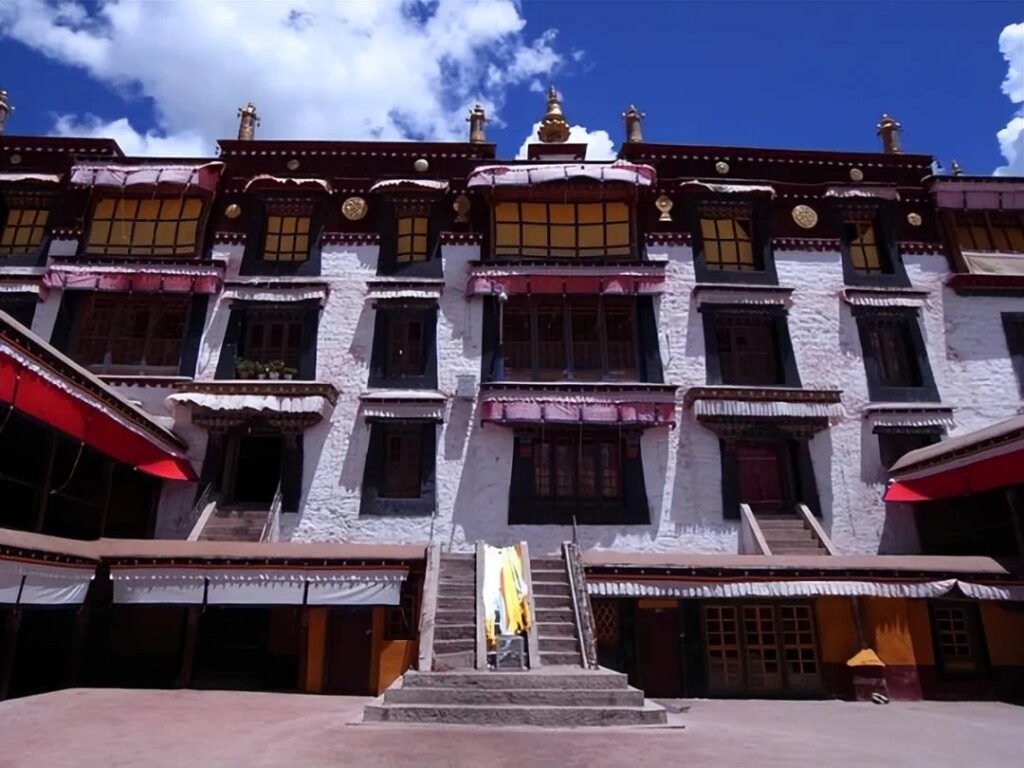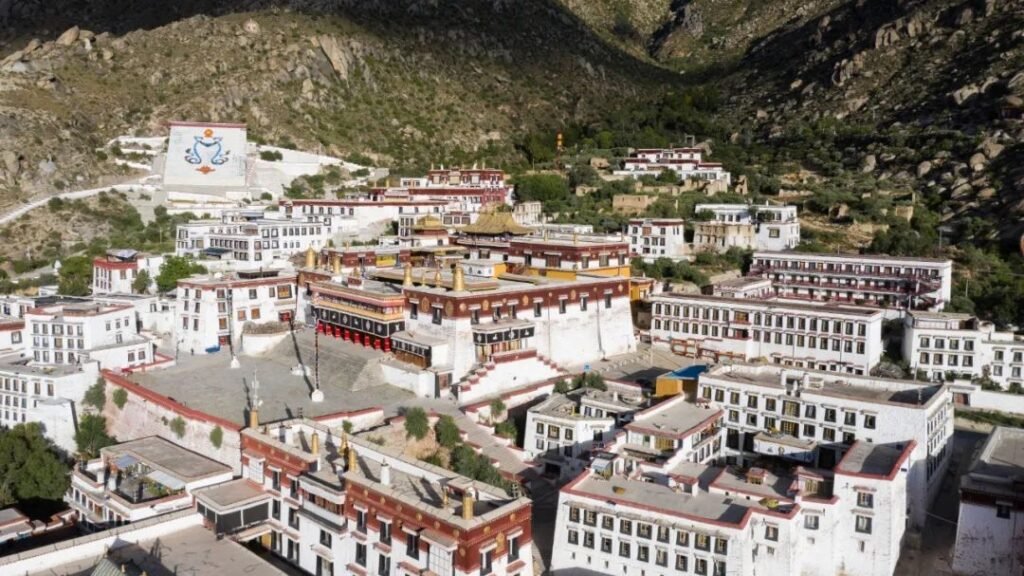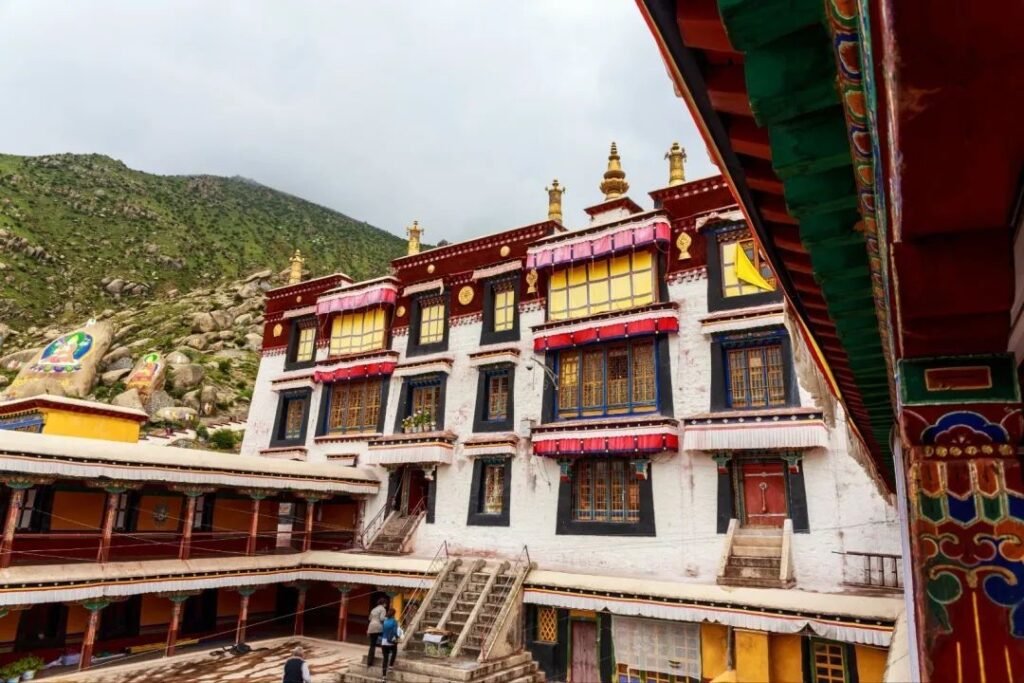The Ganden Phodrang Palace is a key historical and cultural landmark in Tibet, symbolizing the fusion of political power and religious authority that defines Tibetan history. Situated in the southwestern corner of Drepung Monastery in Lhasa, the palace played a pivotal role during the era of the Fifth Dalai Lama and the Ganden Phodrang government, which became the central administrative authority of Tibet. Constructed on the slopes of a mountain, the palace is a majestic architectural marvel, embodying the spiritual and political weight of its time.

Ganden Phodrang: The Palace of Bliss and Tibet’s Political Epicenter
The Ganden Phodrang, meaning “Palace of Bliss,” was constructed in 1530 under the guidance of the Second Dalai Lama, Gendun Gyatso, who was then serving as the 10th Abbot (or Triba) of Drepung Monastery. This majestic palace became the residence of the Third, Fourth, and Fifth Dalai Lamas, all of whom also held the position of the monastery’s Abbot during their respective times.

Historical Role of Ganden Phodrang
Under the Fifth Dalai Lama, the Ganden Phodrang rose to unprecedented prominence. The Fifth Dalai Lama, often referred to as the “Great Fifth,” established a strong central government that came to be known as the Ganden Phodrang Government. With its administrative affairs managed from this palace, Ganden Phodrang became the political and spiritual heart of Tibet.
However, as the Fifth Dalai Lama later shifted the government’s operations to the Potala Palace, the Ganden Phodrang remained a historic symbol of Tibet’s unique blend of spirituality and governance.
The architecture of the Ganden Phodrang and the broader Drepung Monastery complex is a shining example of Tibetan grandeur. The monastery’s structures are adorned with gold roofs, dharma wheels, banners, and the Eight Auspicious Symbols of Buddhism. These elements not only elevate the aesthetic appeal but also reinforce the sanctity and spiritual atmosphere of the site.
Ganden Phodrang’s elegant designs represent the pinnacle of traditional Tibetan architecture. The use of intricate Buddhist motifs and symbolic elements enhances its grandeur, making it one of Tibet’s most iconic landmarks.
Cultural and Religious Legacy Ganden Phodrang
The Ganden Phodrang is more than a physical structure; it is a repository of Tibetan history, spirituality, and cultural identity. Its role as a political hub during the Fifth Dalai Lama’s era cemented its place in Tibetan history, while its architectural beauty continues to draw visitors from around the world.

Architectural Design and Layout of the Ganden Phodrang Palace
The Ganden Phodrang Palace, perched on a south-facing slope, exemplifies a harmonious blend of traditional Tibetan architecture and strategic design, reflecting its dual purpose as a spiritual sanctuary and a bastion of political authority. Spanning approximately 5,700 square meters, the palace is enclosed by imposing stone walls, imparting a fortress-like appearance that underscores its historical significance.
Key Architectural Features
The architectural layout of the palace is thoughtfully divided into three primary sections, each serving unique purposes:
1. The Courtyards
The palace’s courtyards form the vibrant nucleus of the complex. The central courtyard, expansive and open, is encircled by two-story galleries and residential quarters. This area serves as a communal hub and a functional space for administrative and ceremonial activities. Access to the central courtyard is through a smaller, outer courtyard, which acts as the primary entryway into the palace grounds, creating a transition between the external world and the sanctity of the palace.
2. The Main Building
At the heart of the palace complex lies the main building, a meticulously designed three-story structure elevated over two meters above the central courtyard. Its terraced stone walls follow the natural contours of the hill, seamlessly integrating the building with its surroundings. The structure’s roof, constructed with wooden beams and compacted earth, showcases the durability and ingenuity of traditional Tibetan architectural techniques. This building serves as the focal point of both spiritual and administrative functions within the palace.
3. The Throne Room
The pinnacle of the palace’s design is the throne room, situated on the third floor of the main building. This room houses the elaborately carved and ornamented throne of the Fifth Dalai Lama, symbolizing his unparalleled authority in Tibetan society. Beyond its political importance, the throne room embodies spiritual sanctity, representing the profound reverence accorded to the Dalai Lama’s leadership. Its intricate design and strategic placement highlight its role as both an administrative center and a sacred space.

Integration of Form and Function Ganden Phodrang
The Ganden Phodrang Palace’s architectural design is a testament to the ingenuity of Tibetan craftsmanship. By harmonizing traditional elements with practical considerations for defense and governance, the palace remains a monumental symbol of Tibet’s rich cultural and spiritual heritage. Its design not only prioritizes functionality but also pays homage to the natural landscape, creating a structure that stands as a testament to the enduring legacy of Tibetan architecture.
By focusing on these architectural nuances, the Ganden Phodrang Palace offers an insightful glimpse into Tibet’s historical and cultural identity, making it an enduring attraction for historians, architects, and visitors alike.

Functional Spaces within the Ganden Phodrang Palace
The Ganden Phodrang Palace is not just a political center; it is a well-planned complex with spaces designated for various functions that supported the Dalai Lama’s daily activities, both secular and religious.
1. Residential Quarters
The Dalai Lama had separate living spaces for the winter and summer months, allowing for comfort in all seasons. These quarters were complemented by beautifully landscaped courtyards, providing an oasis of serenity amidst the busy life of governance.
2. Religious and Administrative Halls
The palace housed several rooms used for religious ceremonies and administrative functions, including rooms for the Dalai Lama’s spiritual activities, meetings with high-ranking monks, and governance duties.
3. Service Rooms
There were also rooms dedicated to the staff, including storerooms, kitchens, and stables, ensuring the smooth running of the palace and its extensive needs.

Cultural and Symbolic Importance Ganden Phodrang
The Ganden Phodrang Palace is not just an architectural achievement but also a symbol of Tibet’s rich cultural heritage. It represents the integrated power of the Dalai Lama, who served as both the spiritual leader of Tibet and the political ruler of the Ganden Phodrang. The palace’s design reflects this dual role, combining the practicality of governance with the sacred purpose of the Dalai Lama’s religious duties.
Throughout its history, the Ganden Phodrang Palace has remained a site of pilgrimage and a place of immense reverence for Tibetans. The palace’s design reflects the region’s focus on spiritual harmony and political stability, making it an enduring symbol of Tibetan Buddhism and its influence on the governance of Tibet.
Legacy and Preservation
Over the centuries, the Ganden Phodrang Palace has been a vital center of Tibetan culture, politics, and spirituality. It not only housed the Dalai Lama’s administrative functions but also played an integral role in the development of Tibetan theocracy. Although damaged during political upheavals in Tibet’s history, the palace’s significance remains unshaken.
The palace’s meticulous design, blending functionality with spiritual symbolism, continues to make it an enduring icon of Tibetan culture and governance, reflecting the deep intertwining of religion and politics that has shaped the history of Tibet for centuries.

Detailed Insights into Preservation and Modern-Day Significance
In contemporary times, efforts have been made to preserve the Ganden Phodrang Palace as a heritage site. Restoration projects aim to maintain the authenticity of its architecture while ensuring structural integrity. These efforts are crucial for educating future generations about the palace’s historical and cultural importance.
As a focal point of Tibetan history, the palace attracts scholars, historians, and tourists from around the world. It serves as a testament to the resilience of Tibetan culture and its ability to adapt and thrive despite challenges. The palace’s legacy as a symbol of spiritual and political unity continues to inspire those who visit its sacred grounds.
The Ganden Phodrang Palace stands as a remarkable example of Tibetan architecture and cultural heritage. Its intricate design, functional spaces, and symbolic significance reflect the dual roles of the Dalai Lama as both a spiritual leader and a political figure. As efforts to preserve this historic site continue, the palace remains an enduring symbol of Tibet’s rich history and its contributions to global cultural and spiritual traditions.
